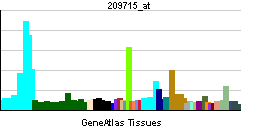CBX5 (gene)
| Chromobox homolog 5 (HP1 alpha homolog, Drosophila) | |||||||||||
|---|---|---|---|---|---|---|---|---|---|---|---|
| Identifiers | |||||||||||
| Symbols | CBX5 ; HP1; HP1-ALPHA; HP1Hs-alpha | ||||||||||
| External IDs | Template:OMIM5 Template:MGI HomoloGene: 7257 | ||||||||||
| |||||||||||
| RNA expression pattern | |||||||||||
 | |||||||||||
| More reference expression data | |||||||||||
| Orthologs | |||||||||||
| Template:GNF Ortholog box | |||||||||||
| Species | Human | Mouse | |||||||||
| Entrez | n/a | n/a | |||||||||
| Ensembl | n/a | n/a | |||||||||
| UniProt | n/a | n/a | |||||||||
| RefSeq (mRNA) | n/a | n/a | |||||||||
| RefSeq (protein) | n/a | n/a | |||||||||
| Location (UCSC) | n/a | n/a | |||||||||
| PubMed search | n/a | n/a | |||||||||
Chromobox homolog 5 (HP1 alpha homolog, Drosophila), also known as CBX5, is a human gene.[1]
Heterochromatin protein-1 (HP1) is a methyl-lysine binding protein localized at heterochromatin sites, where it mediates gene silencing.[supplied by OMIM][1]
See also
References
Further reading
- Saunders WS, Chue C, Goebl M; et al. (1993). "Molecular cloning of a human homologue of Drosophila heterochromatin protein HP1 using anti-centromere autoantibodies with anti-chromo specificity". J. Cell. Sci. 104 ( Pt 2): 573–82. PMID 8505380.
- Ye Q, Worman HJ (1996). "Interaction between an integral protein of the nuclear envelope inner membrane and human chromodomain proteins homologous to Drosophila HP1". J. Biol. Chem. 271 (25): 14653–6. PMID 8663349.
- Sugimoto K, Yamada T, Muro Y, Himeno M (1997). "Human homolog of Drosophila heterochromatin-associated protein 1 (HP1) is a DNA-binding protein which possesses a DNA-binding motif with weak similarity to that of human centromere protein C (CENP-C)". J. Biochem. 120 (1): 153–9. PMID 8864858.
- Ye Q, Callebaut I, Pezhman A; et al. (1997). "Domain-specific interactions of human HP1-type chromodomain proteins and inner nuclear membrane protein LBR". J. Biol. Chem. 272 (23): 14983–9. PMID 9169472.
- Lessard J, Baban S, Sauvageau G (1998). "Stage-specific expression of polycomb group genes in human bone marrow cells". Blood. 91 (4): 1216–24. PMID 9454751.
- Ainsztein AM, Kandels-Lewis SE, Mackay AM, Earnshaw WC (1999). "INCENP centromere and spindle targeting: identification of essential conserved motifs and involvement of heterochromatin protein HP1". J. Cell Biol. 143 (7): 1763–74. PMID 9864353.
- Minc E, Allory Y, Worman HJ; et al. (1999). "Localization and phosphorylation of HP1 proteins during the cell cycle in mammalian cells". Chromosoma. 108 (4): 220–34. PMID 10460410.
- Murzina N, Verreault A, Laue E, Stillman B (1999). "Heterochromatin dynamics in mouse cells: interaction between chromatin assembly factor 1 and HP1 proteins". Mol. Cell. 4 (4): 529–40. PMID 10549285.
- Nielsen AL, Ortiz JA, You J; et al. (2000). "Interaction with members of the heterochromatin protein 1 (HP1) family and histone deacetylation are differentially involved in transcriptional silencing by members of the TIF1 family". EMBO J. 18 (22): 6385–95. doi:10.1093/emboj/18.22.6385. PMID 10562550.
- Zhao T, Heyduk T, Allis CD, Eissenberg JC (2000). "Heterochromatin protein 1 binds to nucleosomes and DNA in vitro". J. Biol. Chem. 275 (36): 28332–8. doi:10.1074/jbc.M003493200. PMID 10882726.
- Lechner MS, Begg GE, Speicher DW, Rauscher FJ (2000). "Molecular determinants for targeting heterochromatin protein 1-mediated gene silencing: direct chromoshadow domain-KAP-1 corepressor interaction is essential". Mol. Cell. Biol. 20 (17): 6449–65. PMID 10938122.
- Song K, Jung Y, Jung D, Lee I (2001). "Human Ku70 interacts with heterochromatin protein 1alpha". J. Biol. Chem. 276 (11): 8321–7. doi:10.1074/jbc.M008779200. PMID 11112778.
- Lachner M, O'Carroll D, Rea S; et al. (2001). "Methylation of histone H3 lysine 9 creates a binding site for HP1 proteins". Nature. 410 (6824): 116–20. doi:10.1038/35065132. PMID 11242053.
- Bannister AJ, Zegerman P, Partridge JF; et al. (2001). "Selective recognition of methylated lysine 9 on histone H3 by the HP1 chromo domain". Nature. 410 (6824): 120–4. doi:10.1038/35065138. PMID 11242054.
- Nielsen AL, Oulad-Abdelghani M, Ortiz JA; et al. (2001). "Heterochromatin formation in mammalian cells: interaction between histones and HP1 proteins". Mol. Cell. 7 (4): 729–39. PMID 11336697.
- Wheatley SP, Carvalho A, Vagnarelli P, Earnshaw WC (2001). "INCENP is required for proper targeting of Survivin to the centromeres and the anaphase spindle during mitosis". Curr. Biol. 11 (11): 886–90. PMID 11516652.
- Scholzen T, Endl E, Wohlenberg C; et al. (2002). "The Ki-67 protein interacts with members of the heterochromatin protein 1 (HP1) family: a potential role in the regulation of higher-order chromatin structure". J. Pathol. 196 (2): 135–44. doi:10.1002/path.1016. PMID 11793364.
- Weinmann AS, Yan PS, Oberley MJ; et al. (2002). "Isolating human transcription factor targets by coupling chromatin immunoprecipitation and CpG island microarray analysis". Genes Dev. 16 (2): 235–44. doi:10.1101/gad.943102. PMID 11799066.
- Sugimoto K, Tasaka H, Dotsu M (2002). "Molecular behavior in living mitotic cells of human centromere heterochromatin protein HPLalpha ectopically expressed as a fusion to red fluorescent protein". Cell Struct. Funct. 26 (6): 705–18. PMID 11942629.
- Vassallo MF, Tanese N (2002). "Isoform-specific interaction of HP1 with human TAFII130". Proc. Natl. Acad. Sci. U.S.A. 99 (9): 5919–24. doi:10.1073/pnas.092025499. PMID 11959914.
External links
- CBX5+protein,+human at the US National Library of Medicine Medical Subject Headings (MeSH)
| This protein-related article is a stub. You can help Wikipedia by expanding it. |
This article incorporates text from the United States National Library of Medicine, which is in the public domain.